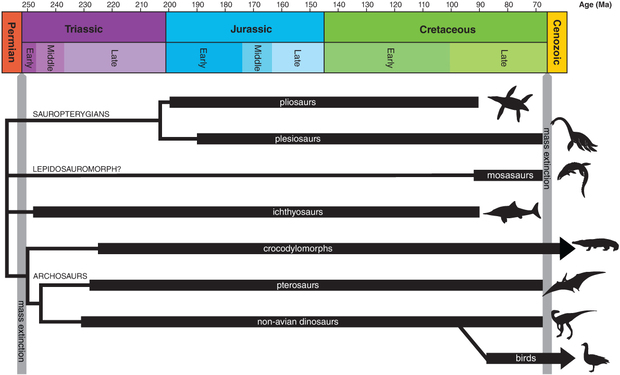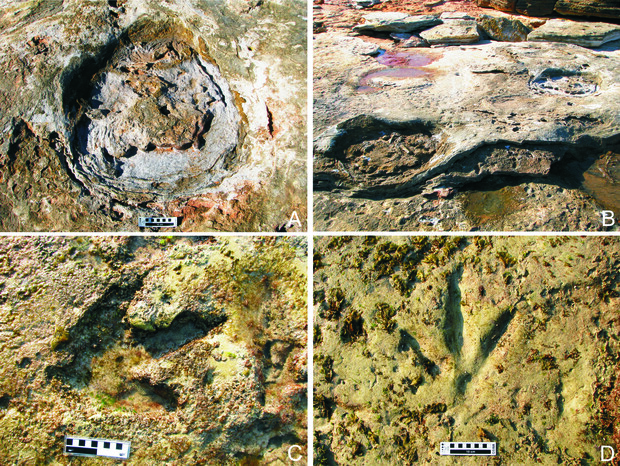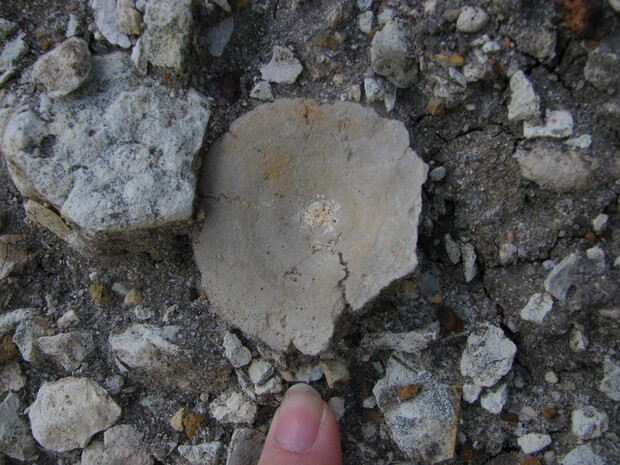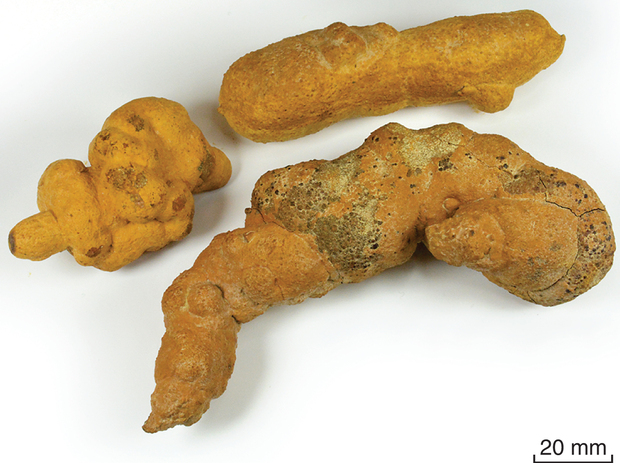Dinosaur fossils are incredibly rare in Western Australia. Most of what we understand about dinosaurs in the State comes from a few isolated bones, and trackways (sets of footprints) found near Broome. Besides dinosaurs, the Mesozoic was filled with other distinctive reptile groups, including crocodiles, pterosaurs (flying reptiles) and a range of marine reptile groups. None of these groups are dinosaurs, although some (crocodiles and pterosaurs) were related to dinosaurs. Pterosaurs and various marine reptiles of this age have also been discovered in Western Australia.

The Mesozoic era, commonly known as the Age of the Dinosaurs, is a subdivision of geological time extending from 252 to 66 million years ago. Geologists divide the era into three periods: the Triassic (252–201 million years ago), the Jurassic (201–145 million years ago), and the Cretaceous (145–66 million years ago).
The Mesozoic era started and ended with two big mass extinctions — the Permian–Triassic extinction event (around 252 million years ago) and the Cretaceous–Paleogene extinction event (around 66 million years ago). The Permian–Triassic event is considered to have been the most devastating mass extinction in geological history, with estimates suggesting 85 per cent or more of all organisms becoming extinct. By contrast, the more widely known Cretaceous–Paleogene event is thought to have caused the extinction of 75 per cent or more of all species.
Dinosaurs
Dinosaurs are the best known of the large reptiles seen in the Mesozoic, first appearing in the Late Triassic and diversifying rapidly in the Jurassic and Early Cretaceous. Other marine or aerial reptiles (pterosaurs) are related to, but not the same, as dinosaurs. The diversity of the dinosaurs decreases throughout the Late Cretaceous, and the entire group, apart from the birds, became extinct at the end of the Cretaceous.
To date, very few dinosaur bones have been found in Western Australia:
- Two bones from a small agile theropod (a two-legged meat-eating dinosaur) named Ozraptor subotaii (Long & Molnar, 1998), found near Geraldton in the Colalura Sandstone (Middle Jurassic, c. 170 million years old)
- A vertebra (back bone) of an unidentifiable theropod, found near Kalbarri in the Birdrong Sandstone (Lower Cretaceous, c. 130 million years old)
- A partial humerus (upper arm bone) of an unknown theropod, found near Exmouth in the Miria Formation (Upper Cretaceous, c. 70 million years old)
- A single toe bone, likely belonging to a small theropod, found near Gingin in the Molecap Greensand (Upper Cretaceous, c. 90 million years old).
The low number of dinosaur fossils found in Western Australia is due to the lack of exposed rocks of the right age and the right environments suitable for the preservation of bones. As dinosaurs lived on land, dinosaur bones are rarely found in rocks deposited under oceanic conditions, and these finds tend to be individual bones rather than complete skeletons. River and swamp deposits are much more likely to preserve dinosaur bones, but it is a delicate balance — if the river flows too quickly the bones might get washed away; too slowly means not enough sand to cover the bones quickly, making the bodies likely to be destroyed by scavengers.

Dinosaur walking trail?
The best evidence for Western Australian dinosaurs is found near and north of Broome (in the Lower Cretaceous Broome Sandstone, c. 130 million years old). Here, there are several beach exposures with pavements of dinosaur footprints, scattered along the coast for about 60 kilometres.
These footprints range in size from a few centimetres up to a metre across, and represent many different types of dinosaurs, both herbivores and carnivores. Footprints include those of sauropods (long-necked dinosaurs) and a few types of large theropods. One of these theropods is like Allosaurus or Megalosaurus, while another resembles Carnosaurus. Other herbivore footprints represent small and large varieties of ornithopod, commonly found at similarly aged localities in Victoria, ankylosaurs or large armour-plated dinosaurs, of which Queensland’s Minmi is a representative, and a single footprint thought to belong to a stegosaur.
The tracks provide valuable information on the diversity of dinosaurs in Australia at the time, their community structure and even aspects of their individual style of movement. The sites are considered to be of world significance due to the diversity of footprints seen. The trackways, as part of the West Kimberley, were registered on the Australian National Heritage List in 2011. As the trackways are very close to the coast, some of them can only be visited when the tide is low; at high tide, the tracks are covered by the ocean. The footprints will eventually be completely eroded by waves, but other buried footprints will likely become exposed in time.
Unfortunately these trackways have proven to be very attractive to illegal fossil traders. In 1996, a rare stegosaur footprint was stolen, and in 1997 a theropod footprint was also taken. Although the theropod footprint was recovered and the thief caught, the stegosaur footprint has never been found.
Other giant reptiles of the Mesozoic

Dinosaurs were not the only large animals to live during the Mesozoic era — pterosaurs and a variety of marine reptile groups are known from Western Australia during this time.
Flying wonders
Pterosaurs are the earliest known vertebrates to develop powered flight. They are not dinosaurs, but are instead distinct animals related to both crocodiles and dinosaurs (within a group called Archosauria), but more closely related to dinosaurs. Pterosaurs first evolved in the Late Triassic and were the dominant aerial group prior to the evolution of birds. Like birds today, different groups of pterosaurs had different life habits and food preferences, including groups that hunted small reptiles and mammals, some that were scavengers, and others that ate fish or ammonoids (shelled molluscs related to octopi and squid). Some pterosaurs had massive wingspans — Quetzalcoatlus from South America is thought to have had a wingspan of 10 to 11 metres, or about the size of an ultralight plane.
The only record of this group in Western Australia is a partial ulna (forearm bone) found near Exmouth in the Upper Cretaceous Miria Formation (c. 70 million years old). Although the fossil is incomplete, reconstructions of this animal suggest a 3.5 to 5 metre wingspan.
Pterosaurs are uncommon in Australia, with only five other records — all Cretaceous in age — recorded from Queensland, Victoria and New South Wales. All of these records consist of single or a small collection of bones. Some, such as the Victorian and New South Wales pterosaurs, have not yet been formally described by scientists. We still have a lot to learn about the flying inhabitants of Australia in the Mesozoic.
Marine terrors
Like pterosaurs, the large marine reptiles seen in the Mesozoic were not dinosaurs. And in fact, none of the major groups of reptiles are closely related to dinosaurs, pterosaurs or even each other. These four groups are:
- ichthyosaurs — fish-like or dolphin-like marine reptiles with big eyes
- mosasaurs — elongate, crocodile-like reptiles considered ancestral to snakes
- plesiosaurs — long-necked reptiles with swimming paddles
- pliosaurs — short-necked relatives of the plesiosaurs.
Many marine reptile remains have been found in Western Australia, mostly in the Carnarvon Basin, where most of the Early Cretaceous rocks were deposited within oceans. In the Perth Basin to the south, the only marine rocks were deposited in the Late Cretaceous, so these two basins preserve very different types of marine reptiles.
Records include:
- fragments of a mosasaur (giant marine reptiles possibly ancestral to snakes) in the Upper Cretaceous Molecap Greensand near Dandaragan, and the Upper Cretaceous Miria Formation near Exmouth
- ichthyosaur bones in the Lower Cretaceous Alinga Formation (c. 120 million years old) just above the Birdrong Sandstone in the hills north of Kalbarri, and the Molecap Greensand near Dandaragan
- a pliosaur, Leptocleidus clemai (described by Cruickshank & Long, 1997) from the Birdrong Sandstone near Kalbarri is presently the most complete Mesozoic reptile skeleton found in Western Australia
- fragmentary pliosaur bones in the Barrow Group and Gearle Siltstone (Upper Cretaceous; c. 95 million years old) of the Carnarvon Basin, and in the Molecap Greensand of the Perth Basin
- vertebrae and other parts of elasmosaurs (long-necked plesiosaurs) in the Molecap Greensand.
Marine reptiles are also very common across Australia, but particularly in Queensland and New South Wales. During the Early Cretaceous (c. 110 million years ago), this part of Australia was covered by a large inland sea, called the Eromanga Sea. This area is particularly rich in vertebrate fossils, including dinosaurs, marine reptiles, pterosaurs, and early mammals.
Precious coprolites
Fossil dung, known as coprolites, is common in the fossil record, but can be easily mistaken for non-fossiliferous nodules. Like other fossils, coprolites have undergone a lot of physical and chemical alteration during the time of burial and fossilisation, so you won’t get dirty hands or any diseases from picking up fossil faeces.

Although it can be very difficult to identify who produced the dung, the variety of shapes and sizes of coprolites in a deposit can be used to understand the range and types of animals living in a past environment, even in areas where you do not see other evidence for life.
Like other fossils, coprolites can be replaced by other minerals after fossilisation, removing their internal structure. However, if internal structure can be seen, scientists can often identify what the animal was eating at the time, which helps paleontologists reconstruct past food webs. Unfortunately, the difficulty in identifying coprolites and their trace makers, means that few coprolites are as completely studied as bones, shells or other fossils, and we often do not have a good understanding of where to find coprolites or how to interpret them.
Within Western Australia there are a number of places where you can see coprolites — these are often places where fossil dinosaurs or marine reptiles have also been found.
Some of the best coprolites can be found in the Hill Spring area in the Gascoyne region. The coprolites are preserved within the Gearle Siltstone of the Carnarvon Basin, a marine unit from which pliosaur bones have also been collected. The coprolites are large and well formed, which suggests that they were made by a large dolphin-sized animal, probably one of the marine reptiles known to have lived in the area at the time, such as pliosaurs, plesiosaurs or ichthyosaurs.
The coprolites come in a variety of shapes, including ‘cigar-shaped’ examples that appear to have rolled around on the seafloor for a long time before being buried. Unfortunately, the internal structure of these coprolites was not preserved, and the dung has been replaced by a number of different minerals. Interestingly, the Gearle coprolites contain unusually high amounts of platinum-group metals, gold, and silver — although not nearly enough of these metals to make them worth mining.
Coprolites from the Gearle Siltstone can be seen on display in the foyer of the department's East Perth office. This display is free and open during normal office hours.
Becoming extinct
Although the ichthyosaurs became extinct in the middle of the Cretaceous period, all remaining pterosaurs and marine reptiles, and most dinosaurs, became extinct at the end of the Cretaceous period, around 65 million years ago. Only one group of dinosaurs survived these changes, the birds. These birds had evolved from theropod dinosaurs earlier in the Mesozoic and were already well established in the Cretaceous. Western Australia presently has no evidence of Mesozoic birds, although rare remains have been found elsewhere is Australia. Crocodilians also survived the mass extinction event, along with birds and the early mammals.
There is continuing debate around what triggered the massive, global changes in environment that mark the end of the Cretaceous and caused the extinction event. Many scientists consider an asteroid impact to be a critical influence, and a very large crater of the right age has been found at Chicxulub in Mexico. However, it is likely that a combination of factors, rather than one single event, caused the extinction of these giant animals.
Although Western Australia currently has only a sparse record of dinosaurs and other Mesozoic reptile groups, the State has many remote regions that still require investigation. Therefore, it is likely that new fossils will be found, and we will continue to learn more about the fascinating previous residents of our State. Many of the fossils (especially bones) discussed here can be seen in the Western Australian Museum’s Diamonds to Dinosaurs gallery.
Western Australian fossil law
In Western Australia, fossicking and fossil collecting is permitted under the following conditions:
- collectors first obtain a Miner’s Right from the Department of Mines, Industry Regulation and Safety (DMIRS)
- written permission has been granted when collecting on people’s property or pastoral leases
- no collecting is to be made on Crown Reserves (e.g. National Parks, State Forest areas, regulated Geoheritage Reserves) without prior written approval from the relevant State or Federal Government agencies. The only exceptions to this are those State Reserves listed as having a Common, Public Utility or Mining purpose.
All collectors are encouraged to bring interesting fossils to either the Geological Survey of Western Australia or the Western Australian Museum for identification. Understanding what fossils are found and where helps scientists better understand the geology of the State and helps government correctly identify and regulate important fossil sites. See Geoheritage for more information.
Any Australian fossils sent overseas (even for non-commercial purposes) are subject to Federal Heritage laws. See the Federal Moveable cultural heritage website for more information.
More information
- Long, JA 1998, Dinosaurs of Australia and New Zealand and other animals of the Mesozoic Era: Harvard University Press, Cambridge, Massachusetts, USA, 188p
- Long, J 2004, It’s true! Dinosaurs never died: Allen & Unwin, Crows Nest, New South Wales, 88p
- Vickers-Rich, P and Rich, TH 1999, Wildlife of Gondwana: dinosaurs and other vertebrates from the ancient supercontinent: Indiana University Press, Bloomington, Indiana, USA, 304p
- University of California Museum of Paleontology: Those diverse diapsids.
External links covering a range of topics relating to Australian fossils, paleontology and geological time can be found on External websites.
More information on fossils and paleontological data within GSWA
Contact
For more information contact:
paleontology@dmirs.wa.gov.au
